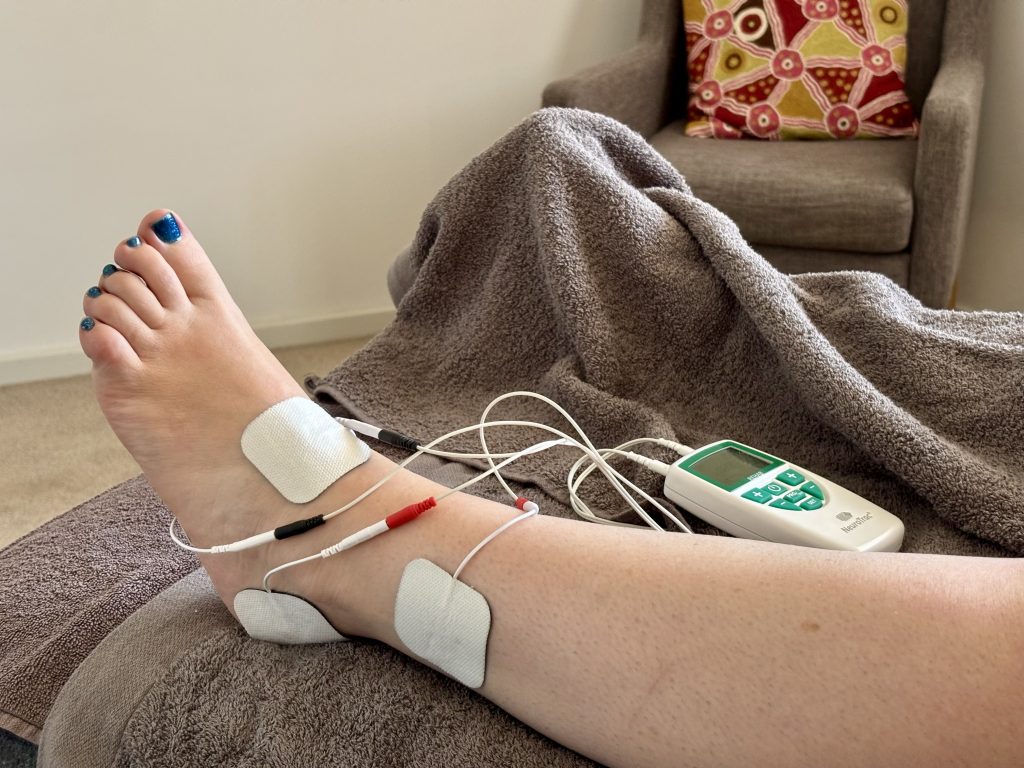
TENS (Transcutaneous Electrical Nerve Stimulation) is a non-invasive, drug-free method of pain relief that has been widely used for decades. It involves the use of a small, battery-operated device that delivers electrical impulses to the skin via electrodes. These impulses help to relieve pain, reduce inflammation, and improve circulation. Whether you’re dealing with chronic pain, acute injuries, or even oedema (swelling), TENS therapy can be a useful tool in managing your symptoms effectively. Read on to discover the benefits of TENS therapy.
How Does TENS Work?
TENS therapy works by stimulating nerves through the skin, producing effects that help to alleviate pain and discomfort. There are two primary mechanisms through which TENS provides pain relief:
1. Gate Control Theory
The electrical impulses from the TENS unit stimulate the nerves in the affected area, effectively “closing the gate” in the spinal cord to pain signals. This means fewer pain messages reach the brain, resulting in reduced sensation of pain.
2. Endorphin Release
TENS can trigger the body to produce endorphins, which are natural painkillers. These chemicals interact with opioid receptors in the brain, reducing the perception of pain and promoting a sense of well-being.
TENS therapy is widely used for conditions such as arthritis, back pain, fibromyalgia, sports injuries, and post-surgical pain. It is also beneficial for managing oedema and promoting circulation.
How to Use TENS for Pain Relief
TENS is an effective tool for managing both chronic and acute pain. Here’s a step-by-step guide on how to use it correctly:
1. Proper Electrode Placement
Ensure the electrodes are placed around the painful area but not directly on wounds or broken skin. Placement varies depending on the type of pain being treated.
2. Adjusting the TENS Unit Settings
Start with a low intensity and gradually increase until you feel a comfortable tingling sensation. Avoid increasing it to the point of discomfort.
3. Duration and Frequency
A typical TENS session lasts between 15 to 30 minutes, and you can use it multiple times per day if necessary.
Safety Precautions
– Avoid placing electrodes on the head, throat, chest (for those with heart conditions), genitals or directly over the spinal cord.
– Do not place pads from front to back of the torso, where the current will pass through the body.
– Consult a healthcare provider before using TENS if you have a pacemaker, epilepsy, or are pregnant.- People who have had lymph node removal due to cancer should be cautious when using TENS for oedema control. Lymph node removal can lead to lymphedema, a condition where fluid accumulates due to impaired lymphatic drainage. While TENS may help with circulation, there is limited evidence on its effectiveness for lymphedema, and improper use could potentially worsen swelling.
Before using TENS, it’s essential to consult a healthcare professional, such as a myotherapist or lymphedema specialist, to ensure it’s safe and appropriate. They may recommend alternative treatments like manual lymphatic drainage (MLD), compression therapy, or specific exercises tailored to post-cancer care.
Tips on TENS placement
For a TENS machine, you should place the pads around the painful area, at least 2.5cm apart.
Recommended placements;
- For lower back pain, place one pad on either side of your spine, or one set above and below the painful area
- For hip pain, place the electrodes so they cross each other
- For neck pain, cover the area of pain
- For migraine, place the pads on either side of your neck, around 1.3 cm below the skin’s surface
Other tips;
- Avoid placing the pads on the front or sides of your neck, the sides of your head, near your eyes or mouth, numb areas, varicose veins, or skin with an infection or irritation
- For more widespread or vague areas of pain, use two channels
- For specific areas of pain, use one channel around either side of the pain , or two channels crossed over the pain area.
- Place each pair of pads diagonally across each other around the treatment area
- Before using TENS at home, consult a medical professional to see if it’s potentially effective for your condition
You can consult a TENS machine placement guide for more specific advice or take your machine to your myotherapy appointment and have your practitioner help you set it to your needs.
Using TENS for Oedema Relief
Oedema, or swelling caused by fluid retention, can also be managed with TENS therapy. The electrical stimulation helps improve circulation and lymphatic drainage, reducing swelling and discomfort. To use TENS for oedema:
– Use a low-frequency setting to promote muscle contractions that help move excess fluid.
– Place electrodes near, but not directly on, the swollen area to stimulate drainage.
– Use shorter sessions (10-20 minutes) to avoid excessive muscle fatigue.
Additional Benefits of TENS Therapy
Beyond pain relief and oedema management, TENS therapy offers several other benefits:
Muscle Relaxation: Helps ease tension and stiffness in muscles.
Improved Mobility: By reducing pain, it allows for better movement and function.
Non-Invasive and Drug-Free Relief: Unlike medications, TENS provides pain relief without the risk of side effects or addiction.
TENS therapy is a versatile, effective, and safe tool for managing pain, swelling, and muscle discomfort. Whether you are recovering from an injury, dealing with chronic pain, or seeking an alternative to medication, incorporating TENS into your pain management routine can be highly beneficial. Always consult with a healthcare professional to ensure proper usage tailored to your specific needs.
ALM Remedial servicing the Yarra Valley, Lilydale, Seville, Wandin, Dandenong ranges areas.



